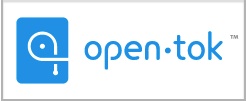-
TokBox Raises $12 Million for In-Browser Video Conferencing
TokBox, a streaming video communications provider, has raised a $12 million Series C round, led by DAG Ventures, to support the rollout of OpenTok, which allows in-browser video conferencing. With the new funding the company has raised $26.4 million to date. I got a demo of OpenTok last week and spoke to company CEO Ian Small and VP of Marketing Micky O'Brien.
What makes OpenTok interesting is that developers can use its JavaScript APIs to build video conferencing right into their web pages. That means that instead of opening separate video chat windows in Skype or other apps, participants appear within the web page itself. With OpenTok's APIs enabled, the web page "listens" and detects video streams from participants' web cameras. Video is controlled in the cloud by media servers which decide how to route the call to appropriate web pages, via Flash. A set of master controls lets the site owner manipulate the prominence of individual participants. Importantly, no plug-in is required by users. They simply click "Join call" or whatever prompt the web site owner implements to invite participants.
participants appear within the web page itself. With OpenTok's APIs enabled, the web page "listens" and detects video streams from participants' web cameras. Video is controlled in the cloud by media servers which decide how to route the call to appropriate web pages, via Flash. A set of master controls lets the site owner manipulate the prominence of individual participants. Importantly, no plug-in is required by users. They simply click "Join call" or whatever prompt the web site owner implements to invite participants.
Integrating video into the web site itself presents lots of interesting new opportunities to developers. OpenTok is announcing a few partners today, The Real News Network, which is integrating OpenTok onto its debate and discussion page, Winkvid, a speed-dating site and Pokerview, an online poker-playing site. As another example, Ian and Micky also showed me an app they mocked up which allows video chatting integrated with trending topics on Twitter. In addition, they see a big market opportunity for enterprise video-conferencing, a space that is still quite fragmented.
Another thing that's interesting is that OpenTok can be syndicated to 3rd-party sites, which means that if for example MTV.com has a video interview with a popular celebrity, that conversation could be picked up and distributed by an infinite number of 3rd-party music sites looking for great content.
For now OpenTok's basic capabilities are being made available for free as the company is interested in seeing what kinds of apps developers create and what business models are used. Depending on what is learned, there will either be premium and/or ad-supported business models introduced. OpenTok is yet another example of the building blocks being introduced to make video pervasive online.
What do you think? Post a comment now (no sign-in required).Categories: Deals & Financings, Live Streaming, Technology

